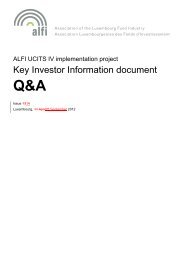Real Estate Investment Funds: Financial reporting - Alfi
Real Estate Investment Funds: Financial reporting - Alfi
Real Estate Investment Funds: Financial reporting - Alfi
You also want an ePaper? Increase the reach of your titles
YUMPU automatically turns print PDFs into web optimized ePapers that Google loves.
property valuation<br />
6. What is the best way<br />
of reconciling multiple<br />
conflicting valuations?<br />
a. Ideally, Fund management should seek<br />
agreement between different valuers to<br />
enable them to agree on one value.<br />
b. If agreement is not possible and both<br />
opinions are credible, a reasonable<br />
methodology for selecting the best point in<br />
the range must be determined by the Fund<br />
management and applied consistently. The<br />
methodology should support the value that<br />
the Fund is most likely to realise from the<br />
property in a normal sale.<br />
7. How should a fund<br />
treat transactions<br />
where the purchase or<br />
sale price varies from<br />
the independent<br />
valuation?<br />
a. CSSF Circular 91/75, and in other cases<br />
(see Chapter VI.2) common and best<br />
practice, dictates that a fund should disclose<br />
the reasons why it proceeded with a<br />
transaction where a "significant" variation<br />
exists between actual price and the value per<br />
the valuation.<br />
b. Often there is a difference between the<br />
theoretical fair value of a property and the<br />
price finally negotiated in an actual<br />
transaction. The threshold of "what is<br />
significant" has been held in other countries<br />
to lie between 5 and 10% variation. The<br />
focus is on the downside – proceeding on<br />
terms more favorable than the valuation is<br />
obviously acceptable. For accounting<br />
purposes, adopting the transaction price in<br />
such a "downside" case is preferred to using<br />
the valuation, as recent transaction<br />
information is considered to be stronger<br />
evidence of the likely market price.<br />
c. The Fund may choose to proceed with a<br />
transaction where the price significantly<br />
exceeds the independent valuation, as this<br />
may, nonetheless, be considered a potentially<br />
valid investment management decision.<br />
However, such a decision should be justified<br />
in writing with appropriate detailed<br />
calculations to support the Fund’s action and<br />
formally approved by the Fund management.<br />
8. How should a fund<br />
treat property portfolio<br />
premiums?<br />
a. When a portfolio of properties is acquired<br />
and a portfolio premium is paid, such<br />
premium usually does not satisfy the<br />
recognition criteria under IFRS and cannot<br />
be recorded in addition to the fair values of<br />
the individually valued properties. However,<br />
if it is an intention to sell the properties in<br />
the portfolio in the future and the premium<br />
can be justified (e.g. with a reference to<br />
valuation report and that it is compliant with<br />
the REIF’s governing documentation) an<br />
adjustment could possibly be made as a<br />
reconciling item between the Fund NAV and<br />
IFRS or, if the REIF is applying Luxembourg<br />
GAAP, directly in the statement of net assets.<br />
In either case, a full and detailed disclosure<br />
of the rationale for recognising the amount,<br />
the methodology of its calculation and the<br />
quantum of the amount should be made.<br />
The estimate of the intended method of disposal<br />
should be reviewed by the Fund management at<br />
each Fund NAV calculation date.<br />
8

















